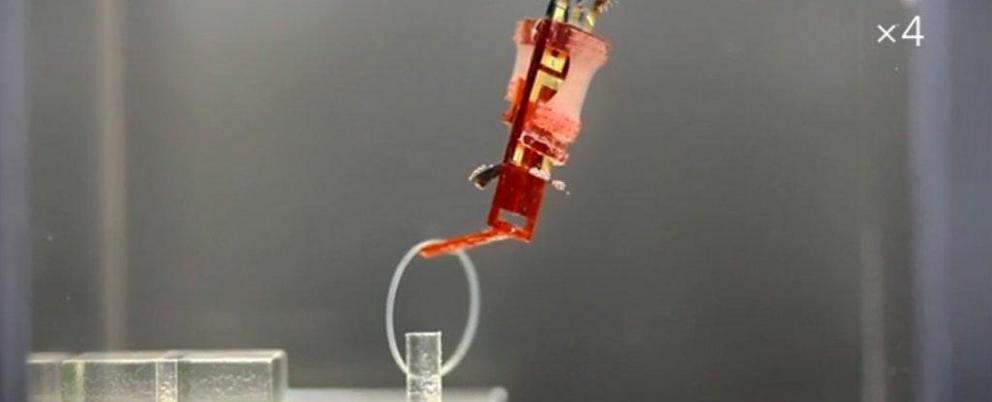These freaky things with real, disembodied muscle tissue could be the next step in robotics
Powering cold, hard mechanics with muscle tissue is a promising idea that so far hasn't delivered awe-inspiring results.
But a new way to grow muscles and attach them to a frame could help overcome existing hurdles, resulting in a biological hybrid device that isn't just stronger than previous attempts, but lasts longer as well.
Engineers at the University of Tokyo developed a method for growing muscle cells from rats on flexible hydrogel sheets and then pairing them to move in opposing fashions on a synthetic skeletal frame.
It's not exactly a T-800 cyborg Terminator, but the whole set-up has been a step up on previous attempts to marry flesh with robotics.
Nature has done a top job evolving high precision, power-efficient mechanical actuators - the mechanism that turns an input signal into movement. We call it muscle tissue.
But translating muscles from a living system to a synthetic frame is easier said than done, as the biochemistry of muscle cells forces them to pull inward and shrink over time.
"This spontaneous shrinkage makes the skeletal muscle tissues much shorter than their initial length, leading to contraction malfunction," the researchers explain in their report.
In an attempt to get around this problem, muscle tissue can be cultured on a rigid frame. Anchoring it in this way maintains its overall length, but the frame's stiffness makes the muscle less suitable as an actuator, while limiting its power.
Getting a muscle to last without shrinking while remaining strong enough to function has proved challenging, leading researchers to go back to nature once again.
Instead of a stiff frame, this time the team used more bendy layers of hydrogel grooved to accommodate long muscle fibres, which were then seeded with skeletal muscle cells called myoblasts.
To get around the shrinkage problem, the researchers created a synthetic skeleton that connected pairs of muscles in opposition, connecting each to a lever that could be pulled back and forth under the control of a pair of electrodes.
The experiment worked much like a tiny arm, with one muscle acting like miniature biceps and the other like the opposing triceps.
"Once we had built the muscles, we successfully used them as antagonistic pairs in the robot, with one contracting and the other expanding, just like in the body," says senior researcher Shoji Takeuchi.
Thanks to this balancing method, their finger-sized arm was still performing adequate bicep curls a week later.
"The fact that they were exerting opposing forces on each other stopped them shrinking and deteriorating, like in previous studies," says Takeuchi.
A closer look at the arrangement of the cells down the grooves inside the hydrogel frames showed they provided a much higher amount of contractile force than previously. Tinkering with those structures could potentially squeeze even more pulling power out of the muscles.
The researchers conducted several tests on the tiny hybrid machine, manipulating a square shape and picking up a ring with ease.
Admittedly, there's a long way to go before such devices can travel back in time to change the course of history by assassinating people, but we're pretty sure Skynet also would have started with something just as small.
"Our findings show that, using this antagonistic arrangement of muscles, these robots can mimic the actions of a human finger," says the report's lead author Yuya Morimoto.
"If we can combine more of these muscles into a single device, we should be able to reproduce the complex muscular interplay that allow hands, arms, and other parts of the body to function."
Science fiction aside, bioengineered devices based on this kind of technology open up the options for organ replacement and prosthetics in the future.
By blurring the lines between synthetic materials, electronics, and our own flesh, we can more seamlessly integrate life-enhancing technology into our bodies.
At least, that's the plan. Because if we're really just adding flesh and muscle to robots, the kind of abuse we put them under just got a whole lot more complicated.
This research was published in Science Robotics.

